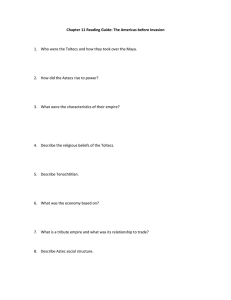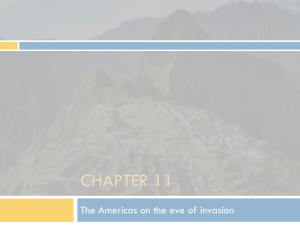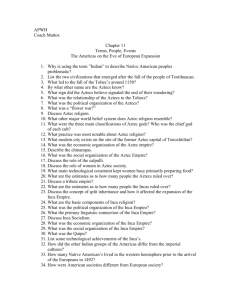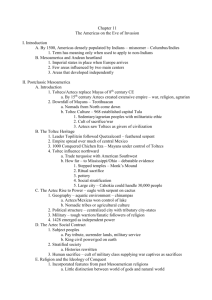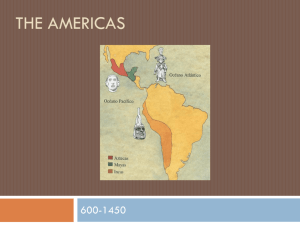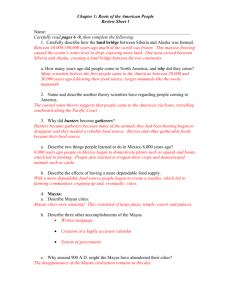The Americas on the Eve of Invasion
advertisement
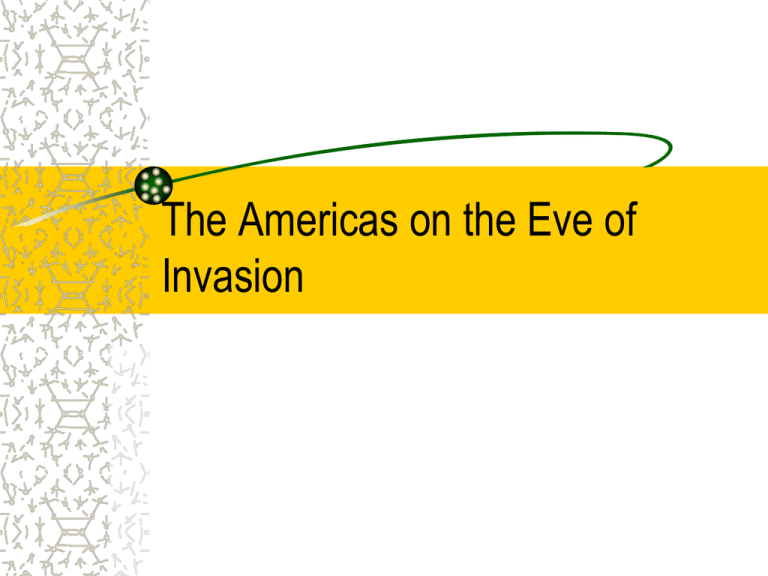
The Americas on the Eve of Invasion Entry Reading Assessment What was unique about the Aztec and Inca civilizations in this time period? Think globally and about the PERSIAN chart characteristics What was similar about the Aztec and Inca civilizations (both compared to each other and the world as a whole) Mesoamerican and South American Civilizations. “It’s like America, but South”- Disney Pixar’s UP 2500s BCE-400 BCE 300s-900s CE 900s-1200s CE 1100s-1500s CE 1300s- 1500s CE Olmec Mayas Toltecs Incas Aztecs Postclassic Mesoamerica, 10001500 CE 8th century collapse of Teotihuacan and abandonment of classical Maya cities Toltecs (nomadic peoples from the north) took advantage of political vacuum left by Maya and established a capital at Tula about 968 Toltec culture adopted any features from the sedentary peoples and added a strongly militaristic ethic The Toltec Heritage Topiltizin- Toltec leader and priest dedicated to the god Quetzalcoatl -legend Toltecs created vast empire that spread over much of central Mexico and as far down as Guatemala North and Easterly influence debated Aztec Rise to Power Toltecs lasted until 1150, when it was destroyed by nomadic invaders from the north People flocked to lake regions and argued over water resources and control of lakes. The Aztecs won this struggle (they called themselves Mexica) Aztec ancestry debated and unclear Aztecs were a group of about 10,000 people who migrated to the shores of Lake Texcoco in the central valley of Mexico After the fall of the Toltecs many people moved to this area and the area around the lake was organized into citystates. Political units claimed power on the basis of military power and connections to Toltec culture Aztec were tough warriors and worshippers of gods, to whom they made sacrifices 1325 founded the city of Tenochtitlan 1428 emerged as an independent power 1434 created an alliance with two other city-states that controlled much of the plateau The Aztec Social Contract Aztec domination vast. Subject peoples made to pay tribute, surrender lands, and do military service Became a stratified society under the authority of a supreme ruler Human sacrifice expanded and military class played central role as suppliers of victims Religion and Ideology of Conquest 128 major deities Each deity had a female form and many had different forms Supported by festivals and ceremonies 3 major themes/cults of gods: gods of fertility and the agricultural cycle (Tlaloc, the god of rain) ; creator deities; cult of warfare and sacrifice (Huitzilopochtli- the Aztec tribal patron) Religion explained the birth and history of the gods and their relationship to peoples Tenochtitlan: The Foundation of Heaven The Aztecs considered their capital a sacred space The palaces and temples were impressive architectural feats 1519 population larger than 150,000 City was an island connected by four waterways, which the calpulli, or kin group, maintained Present-day Mexico City on this site Feeding the People: The Economy of the Empire Agriculture Developed an ingenious system of irrigated agriculture by building chinampas (beds of aquatic weeds, mud, an earth placed in frames and rooted on the lake floor and formed artificial floating islands that were able to bring water to all the plants and produce four corn crops a year) Each Aztec community- local clan apportioned the lands. Individual nobles might have private estates . Each community had markets to exchange goods but they were regulated. Pochteca- special merchant class that specialized in long-distance luxury trade Tribute payments assigned Widening Social Gulf Aztecs had been divided into seven calpulli earlier when they were wandering. They maintained this division to include neighbors, allies, and dependants- they organized labor, military, schools. Calpulli were governed by councils of family heads but not all families were equal As Aztec power expanded a class of nobility emergednobles born into their class and nobles controlled the priesthood and the military leadership Social gulf between nobility and comers grew with the empire As nobility broke free from old calpulli and acquired private lands a new class of workers like serfs developed. Low status but higher than slaves Overcoming Technological Constraints Membership in society defined by participation in wider groups, such as calpulli or specific social class Women had a decent status- had political rights but in reality remained subordinate to men Technology limited social development- women spent 30-40 hours a week preparing food because they had to grind maize by hand Highly dense population A Tribute Empire Each city-state ruled by a speaker chosen from the nobility- The Great Speaker was the ruler of Tenochtitlan and equivalent to an emperor Ancient cult of military virtues elevated to supreme position as the religion of the state and securing tribute for the state drove Aztec conquests Empire never integrated Many revolts against the Aztecs but they ruthlessly put them down Aztecs were a continuation of earlier civilizations- a militarized version of them The Incas 3000 miles in extent in Andean highlands Incorporated many aspects of previous Andean cultures but fused them together in new ways State organization and bureaucratic control- high level of integration After break-up of states of Tihuanaco and Huari (550-1000) several smaller regional states exercised some power Coastal kingdom of Chimur emerged as most powerful. Between 900 and its conquest of the Incas in 1465 it gained the most power Inca Rise to Power Quechua-speaking clans around 1350 living near Cuzco 1438 had defeated hostile neighbors in the area and under Pachacuti (1438-1471) extended control to Lake Titicaca For next 60 years further expanded the empire. Topac Yupanqui (Pachacuti’s son) seized much of north and some of south. Next ruler Huayna Capac consolidated conquests and suppressed rebellions Between 9 and 13 million people of different ethnic backgrounds came under their rule Conquest Cult of the ancestors important in Inca belief Split inheritance – all political power and titles of the ruler went to his successor but all his palaces, wealth, land, and possessions remained in the hands of his male descendents, who used them to support the cult of the dead Inca’s mummy for eternity Self-perpetuating need for conquest Sun highest deity Inca Rule Empire was ruled by the inca, who was considered almost a god Ruled from Cuzco Priest usually a close relative Divided into four great provinces, each under a governor and then divided again State bureaucracy in which nobles played a role Some local practices slowed to continue Spread of Quechua as means of integrating the empire Extracted land and labor from subject empires Inca Rule Did not demand tribute in kind but exacted labor on the lands assigned to the state and religion Labor turns (mita)- essential aspect of control Women almost on equal status- had gender-specific duties but recognized parallel descent. Of course, theory was better than reality. In reality gender hierarchy developed Integration of imperial policy with regional and ethnic diversity a feat. Ethnic headmen kept in place but over them were administrators from Inca nobility in Cuzco Nobility in Cuzco and greatly privileged No development of a special merchant class Emphasis on self-sufficiency By 1520s empire weakened by civil strife Inca Cultural Achievements Metalworking, pottery, cloth, copper and bronze tools and weapons No wheel, no writing system Used numerical system of knots like the abacus to record numerical data like census information Genius at land water management, road system, architecture and public buildings (2500 miles of roads) Comparing Incas and Aztecs Both built on previous civilizations Both represented success at imperial and military organization Both created by the conquest of sedentary agricultural people and the extraction of tribute and labor from them Both older kinship-based institutions changed with the rise in nobility Both recognized local ethnic groups and powers Aztec trade and markets more developed The Other Indians When comparing consider gradations of culture and social complexity Mesoamerica and the Andes supported high levels of population- 67 million total population- almost equal to other groups in the world (china, India- 75-100, Europe- 60-70) Intermediate zone between Mesoamerica and northern South Americaresembled sedentary agricultural states in many ways Chieftainships ruled over many parts of Caribbean, Northwest South America- societies more egalitarian and material culture simple Americas lacked nomadic herders Great diversity in North America- as many as 200 languages by 1500 Some hunter gatherers- northwest coast Indians Most Indian societies strongly kin based, communal action and ownership stressed
